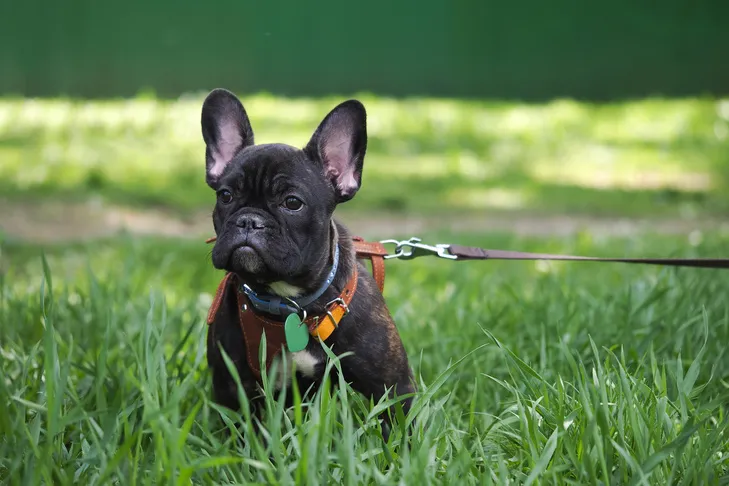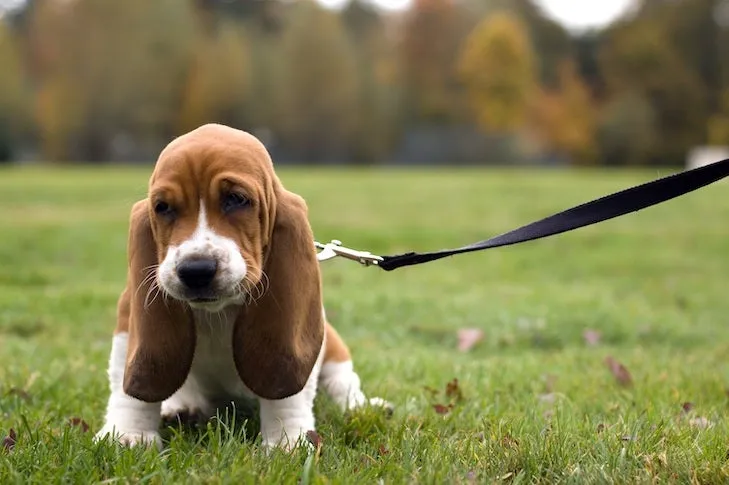Many new puppy parents wonder, “When Should I Start Leash Training My Puppy?” The good news is that you can begin this essential training early, typically as soon as your puppy settles into their new home. Unlike what some might think, walking politely on a leash isn’t an innate skill; it’s something every dog needs to learn. This skill is invaluable for safe and enjoyable outings, and establishing a strong foundation early makes future walks a pleasure for both you and your furry friend. Dog training expert and AKC Family Dog training and behavior columnist Kathy Santo shares foundational tips to get your puppy started on the right paw, ensuring they learn how do i get my puppy to walk outside confidently.
Early Steps: Laying the Foundation for Leash Training
Starting your puppy’s leash training journey with positive experiences is crucial. These initial steps focus on comfort, positive association, and basic responsiveness, setting the stage for more advanced loose-leash walking later on.
1. Introduce Collar, Harness, and Leash
Begin by familiarizing your puppy with wearing a collar or harness and a leash. Let them wear these for very short periods inside the house, especially during playtime or when offering treats. The goal is for your puppy to associate their new gear with positive experiences like food and fun, making “collar-and-leash time” something they eagerly anticipate.
2. Teach a Positive Cue
Establish a consistent sound cue that signals “food is coming.” This could be a clicker, a word like “yes,” or a tongue cluck. In a quiet, distraction-free environment, with your puppy wearing their collar and leash, make the sound. The moment your puppy turns towards you or makes eye contact, immediately reward them with a treat. Repeat this exercise several times until your puppy not only looks at you but also comes to you expecting a reward after hearing the cue.
 French bulldog puppy in a harness sitting in tall green grass on a leash for a walk.
French bulldog puppy in a harness sitting in tall green grass on a leash for a walk.
3. Encourage Coming to You
As your puppy starts heading your way after hearing the cue, take a few steps backward while they are still on leash and collar. Reward them when they reach you. Gradually, extend this progression until your puppy consistently comes and walks with you for several paces upon hearing the cue. Remember that puppies have limited attention spans, so keep training sessions brief and positive, ending before they become mentally fatigued.
4. Practice Indoors
Once your puppy understands how to get your puppy walking on a lead by coming to you, practice walking a few steps in a quiet room with minimal distractions. The sensation of the leash around them will be enough of a challenge initially. Continue to offer treats and praise as your puppy learns to walk alongside you with the leash on. This controlled environment builds confidence before facing the outside world.
5. Transition to the Outdoors
Now, it’s time to take your puppy’s newfound skills to the great outdoors. This step presents new challenges, as the sounds, smells, and sights will be incredibly stimulating. Be patient and keep early outdoor walks very short. If your puppy seems on the verge of lunging or becoming distracted—which you’ll notice by keeping a close eye on them—use your cue sound and move a few steps away. Reward them with a treat for following you. This technique reinforces attention on you amidst distractions, teaching getting your puppy to walk on a leash even in stimulating environments.
 Basset Hound puppy sitting in the grass on lead.
Basset Hound puppy sitting in the grass on lead.
Addressing Common Leash Training Challenges
Even with a solid foundation, puppies may encounter issues as they mature, explore new places, and face more distractions. Teaching loose-leash walking is paramount for both your enjoyment and their ability to pass tests like the Canine Good Citizen. The AKC GoodDog! Helpline offers valuable advice for these common issues.
Dealing with a Pulling Puppy
If your dog begins pulling in the opposite direction, immediately transform yourself into “a tree.” Stand completely still and refuse to move until your dog returns to you. Avoid yanking or jerking the leash or dragging your dog. For persistent pullers, tools like front-hook harnesses and head halters can be effective alternatives, providing better control and discouraging pulling without discomfort.
Managing Lunging Behavior
When your dog starts fixating on something and preparing to lunge—be it another dog, a car, or a skateboarder—proactive intervention is key. Try to redirect their attention with a treat before they have a chance to lunge. Increase the distance between your dog and the target of their attention. Stay vigilant and be prepared to act before the source of their frustration gets too close. This behavior might be more common in herding breeds, but any dog can be startled or overly excited.
Handling Excessive Barking
Some dogs develop a habit of barking at other dogs during walks. This behavior is often a result of insufficient exercise. Ensure your dog receives the appropriate amount of mental and physical stimulation for their age and breed. If barking persists, apply the same strategy used for lunging: create distance and offer treats before they start barking. Consistently doing this will help them associate seeing other dogs with turning their attention back to you, reinforcing how to get your puppy to walk on a leash calmly.
Gradually, you’ll find yourself needing fewer treats and less troubleshooting during walks. However, it’s always a good idea to keep some on hand to randomly reinforce good leash-walking behavior and celebrate their progress.
Resources
- AKC Family Dog Magazine: https://www.akc.org/products-services/magazines/
- Kathy Santo Dog Training: https://www.kathysantodogtraining.com/
- AKC GoodDog! Helpline: https://www.akc.org/products-services/akc-gooddog-helpline/
